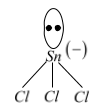
A tin chloride Q undergoes the subsequent reaction (not balanced)
$Q+C{{l}^{-}}\text{ }\to \text{ }X$
$Q+\text{ }M{{e}_{3}}N\to \text{ }Y$
$Q+\text{ }CuC{{l}_{2}}\text{ }\to \text{ }Z+\text{ }CuCl$
X is a monoanion having pyramidal geometry. Both Y and Z are neutral compounds. Choose the right options (this question has multiple correct option)
(A) The central atom in X is $s{{p}^{3}}$ hybridized
(B) There is a dative bond in Y
(C) The oxidation number of the central atom in Z is +2
(D) The central atom in Z has one lone pair of electrons
Answer
139.5k+ views
Hint: As we all know the formula for tin chloride is $SnC{{l}_{2}}$ (where during this question performs some reactions). Monoanion is mentioned as an ion having one charge. Where pyramidal geometry is made by a polyhedron formed by connecting a polygonal base and some extent, called the apex.
Complete step by step answer: In the unified state, the metals are meant to exist as they are present in nature within their compounds. The reactive metals typically exist inside their compound appearance. In the cumulative state the metals are found as oxides, carbonates, sulphides, silicates, phosphates etc. within the planet's crust. Composite Q is $SnC{{l}_{2}}$.
The given reactions are
$SnC{{l}_{2}}+C{{l}^{-}}\to \underset{\left( X \right)}{\mathop{SnCl_{3}^{-}}}\,$
$SnC{{l}_{2}}+M{{e}_{3}}N\to \underset{\left( Y \right)}{\mathop{M{{e}_{3}}\overset{+}{\mathop{N}}\,-\overset{-}{\mathop{Sn}}\,C{{l}_{2}}}}\,$
$SnC{{l}_{2}}+2CuC{{l}_{2}}\to SnC{{l}_{4}}+\underset{\left( Z \right)}{\mathop{2CuCl}}\,$
Hybridisation of $Sn$ in $SnCl_{3}^{-}$is $s{{p}^{3}}$(X)

Trimethylamine forms a co-ordinate bond with $Sn$ in $SnCl_{2}^{{}}$(Y),
and in $SnCl_{4}^{{}}$ there's no lone pair on the central atom of $SnCl_{4}^{{}}$ (Z).
Hence, (Q), (X), (Y) and (Z) are $SnC{{l}_{2}}$, $SnCl_{3}^{-}$, $SnCl_{2}^{{}}$ and $SnCl_{4}^{{}}$ respectively.
Tin (II) chloride is a white crystalline solid with the formula $SnC{{l}_{2}}$ and is also known as stannous chloride. It forms a stable dihydrate, but aqueous solutions, especially if acidic, tend to undergo hydrolysis. $SnC{{l}_{2}}$ is commonly used as a reducing agent, and for tin-plating in electrolytic baths.
Note: Tin ($Sn$) may well be a bunch 14 elements, it show $s{{p}^{3}}$ hybridisation with two bond pairs between $s{{p}^{3}}-p$ orbital of two chlorine atoms and remaining two lone pairs are present. the shape of the molecule is V-shaped.
Complete step by step answer: In the unified state, the metals are meant to exist as they are present in nature within their compounds. The reactive metals typically exist inside their compound appearance. In the cumulative state the metals are found as oxides, carbonates, sulphides, silicates, phosphates etc. within the planet's crust. Composite Q is $SnC{{l}_{2}}$.
The given reactions are
$SnC{{l}_{2}}+C{{l}^{-}}\to \underset{\left( X \right)}{\mathop{SnCl_{3}^{-}}}\,$
$SnC{{l}_{2}}+M{{e}_{3}}N\to \underset{\left( Y \right)}{\mathop{M{{e}_{3}}\overset{+}{\mathop{N}}\,-\overset{-}{\mathop{Sn}}\,C{{l}_{2}}}}\,$
$SnC{{l}_{2}}+2CuC{{l}_{2}}\to SnC{{l}_{4}}+\underset{\left( Z \right)}{\mathop{2CuCl}}\,$
Hybridisation of $Sn$ in $SnCl_{3}^{-}$is $s{{p}^{3}}$(X)

Trimethylamine forms a co-ordinate bond with $Sn$ in $SnCl_{2}^{{}}$(Y),
and in $SnCl_{4}^{{}}$ there's no lone pair on the central atom of $SnCl_{4}^{{}}$ (Z).
Hence, (Q), (X), (Y) and (Z) are $SnC{{l}_{2}}$, $SnCl_{3}^{-}$, $SnCl_{2}^{{}}$ and $SnCl_{4}^{{}}$ respectively.
Tin (II) chloride is a white crystalline solid with the formula $SnC{{l}_{2}}$ and is also known as stannous chloride. It forms a stable dihydrate, but aqueous solutions, especially if acidic, tend to undergo hydrolysis. $SnC{{l}_{2}}$ is commonly used as a reducing agent, and for tin-plating in electrolytic baths.
Note: Tin ($Sn$) may well be a bunch 14 elements, it show $s{{p}^{3}}$ hybridisation with two bond pairs between $s{{p}^{3}}-p$ orbital of two chlorine atoms and remaining two lone pairs are present. the shape of the molecule is V-shaped.
Recently Updated Pages
Average fee range for JEE coaching in India- Complete Details

Difference Between Rows and Columns: JEE Main 2024

Difference Between Length and Height: JEE Main 2024

Difference Between Natural and Whole Numbers: JEE Main 2024

Algebraic Formula

Difference Between Constants and Variables: JEE Main 2024

Trending doubts
JEE Main 2025 Session 2: Application Form (Out), Exam Dates (Released), Eligibility, & More

JEE Main 2025: Derivation of Equation of Trajectory in Physics

Learn About Angle Of Deviation In Prism: JEE Main Physics 2025

Number of sigma and pi bonds in C2 molecule isare A class 11 chemistry JEE_Main

Electric Field Due to Uniformly Charged Ring for JEE Main 2025 - Formula and Derivation

JEE Main 2025: Conversion of Galvanometer Into Ammeter And Voltmeter in Physics

Other Pages
NCERT Solutions for Class 11 Chemistry Chapter 9 Hydrocarbons

NCERT Solutions for Class 11 Chemistry Chapter 7 Redox Reaction

JEE Advanced Marks vs Ranks 2025: Understanding Category-wise Qualifying Marks and Previous Year Cut-offs

NCERT Solutions for Class 11 Chemistry Chapter 5 Thermodynamics

Hydrocarbons Class 11 Notes: CBSE Chemistry Chapter 9

NCERT Solutions for Class 11 Chemistry In Hindi Chapter 1 Some Basic Concepts of Chemistry




